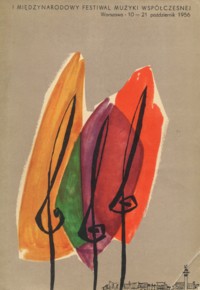Between the two world wars, most Polish composers were associated with the Association des Jeunes Musiciens Polonais, founded in 1926 in Paris. They studied with Vincent d'Indy, Paul Dukas, Albert Roussel and Nadia Boulanger. The dominant style in Polish music was then – neoclassicism, of which Grażyna Bacewicz became the most eminent representative. Shortly before World War II, Witold Lutosławski, Roman Palester and Andrzej Panufnik presented their first works (Lutosławski and Panufnik – in the photo on the right). The 17th Festival of the International Society for Contemporary Music (ISCM), organised in Warsaw and Cracow in April 1939, opened up brilliant opportunities for Polish music, but with the outbreak of the war, these hopes were shattered. Polish music was methodically eradicated as an expression of the national identity, and Chopin performances were banned. Concerts were held only in the underground.
After World War II, in the People’s Republic of Poland, music became a tool which served the communist ideology. Music was to be an instrument of “ideological and artistic education” for the broad mass of the “new” Poland’s population. Many composers left the country - Roman Palester and Andrzej Panufnik among others; their works were banned for many years. The political thaw of 1956 brought some liberalisation also for the musical circles, which gained access to new Western music. The “Warsaw Autumn” International Festival of Contemporary Music was of particular importance in this process. It presented works by the most eminent Polish composers, as well as compositions by promising debutants. The 1960s saw the emergence of the Polish school of composition, distinctly avant-garde in character, formed, among others, by Tadeusz Baird, Kazimierz Serocki and Włodzimierz Kotoński, as well as the younger generation of composers: Henryk Mikołaj Górecki, Krzysztof Penderecki, Wojciech Kilar and Bogusław Schaeffer. For many years, Witold Lutosławski had already held his own place in Polish music, independent from all schools and trends, but setting the standard for all Polish composers.
The 1970s marked the beginning of a trend which rejected radicalism in sound while referring more and more openly to tradition. Even earlier, in 1965, Krzysztof Penderecki, recently made famous by his avant-garde compositions such as
Threnody to the Victims of Hiroshima, revealed his new artistic personality in
St Luke Passion. It was, however, Henryk Mikołaj Górecki’s
Symfonia pieśni żałosnych [
Symphony of Sorrowful Songs] that became the symbol of this change. Its first performance in 1977 was a shock to Polish audiences, whereas fifteen years later the
Symphony caused a sensation among audiences throughout the world; today, it is still the most popular work written by a contemporary Polish composer. The younger generation of composers, with Eugeniusz Knapik and Paweł Szymański, followed in the masters’ footsteps, drawing heavily upon the universal tradition of European music, which they placed into their own, late 20th-century perspective.
Dr Mieczysław Kominek
The previous article:
Karol Szymanowski


